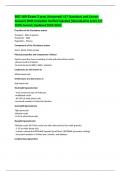Other
BTEC Level 3 Applied Science Unit 9 Assignment C - Understand the role of hormones in the regulation and control of the reproductive system
- Institution
- PEARSON (PEARSON)
BTEC Level 3 Applied Science Unit 9 Assignment C - Understand the role of hormones in the regulation and control of the reproductive system. I was awarded a DISTINCTION for this assignment.
[Show more]












